The Crown’s power women
Two characters have made quite an impact and captured the world’s imagination in recent history: Margaret Thatcher and Princess Diana.
The ’80s probably has some of the boldest looks, from over-the-top to downright ugly, so when Amy Roberts had to design the costumes for Season 4 of Netflix’ s The Crown, which covers the period from 1979 to 1990, she was probably filled with both excitement and a little trepidation.
What also made the job daunting was the introduction of two characters who have made quite an impact and captured the world’s imagination in recent history: Margaret Thatcher and Princess Diana. One changed the face of Britain and the other altered the perception of British monarchy forever. Both strong women, they had complex relationships with the royal family, which had to be reflected in their wardrobe.
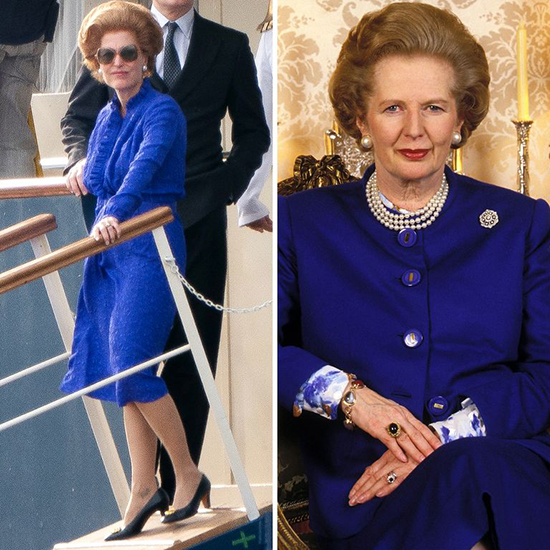
Thatcher, the longest-serving British prime minister of the 20th century and the first woman to hold the office, was dubbed “Iron Lady” by a Soviet journalist for her uncompromising politics and leadership style. Her being a workaholic and willingness to make enemies as she pushed for a free market, pro-privatization brand of conservatism made her a very controversial figure in Britain. It also ran counter to Queen Elizabeth II’s less confrontational leadership style, making a clash inevitable.
Played by Gillian Anderson, Thatcher at first appears in bright blue skirt suits with pussy-bow blouses, an enduring symbol of female power that was an alternative to ties in the male-dominated workplace. Her outfits required “forensic, meticulous construction” with couture fittings so that the power shoulders did not look like an ’80s parody on the actress’ small frame when her look later became stronger and more streamlined.
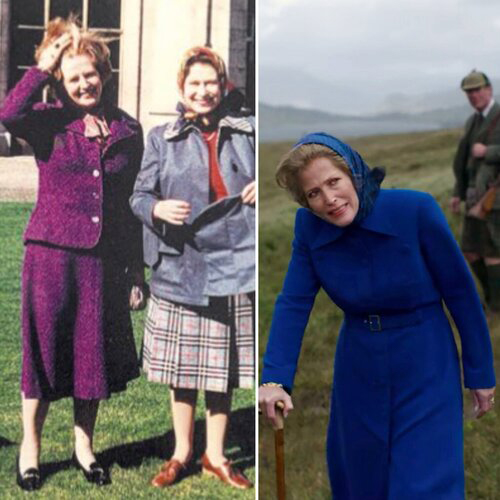
By the time of the Falklands war, the pussy bows are gone. The strained dynamic between the prime minister and the queen (Olivia Colman) reaches its height and is highlighted by putting Thatcher in a “very English, white and blue suit, square shoulders, strong, while the Queen is very maternal and softer in that scene,” according to Roberts.
Early on, the contrast between the two was already apparent, reaching comic proportions when the Thatchers were invited by the Queen to Balmoral for the weekend and the prime minister appeared at 6 p.m. for dinner in a bright purple gown, while the royal family members were in their drab Barbour country jackets.
The next day Thatcher further shows her working-class roots with no appropriate leisure attire, stumbling while stalking the fields wearing a royal blue dress and heels.
Diana Spencer, on the other hand, who was born to British nobility and grew up close to the royal family in the Sandringham estate, was an easy fit and was a tremendous success at Balmoral, easily winning the family’s approval as Prince Charles’ bride-to-be.

In the series, Diana (Emma Corrin) starts off as an awkward young girl with very little fashion sense. On their second meeting with Charles (Josh O’Connor), she is dressed in pale yellow dungarees and later on in dresses and skirts layered with mismatching jumpers — “like a teenager who hasn’t quite got her look, to convey that kind of messiness of her beginnings,” says Roberts.
Diana’s early style was actually typical of Sloane Rangers, which even had a satirical guidebook in the ’80s, describing the sartorial preferences of upper-middle-class residents of the affluent Sloane Square area in London — a girly aesthetic of tweeds, ruffles, floral prints and pearls.
For the engagement announcement in February 1981, Roberts recreated Diana’s royal blue scallop-edged suit by Cojana from Harrods. Bought together with her mother, it’s not a young girl’s look, making her look awkward.

“During this period, I felt we were dressing up a doll,” according to Roberts. The doll reaches Disney fairytale proportions with the famous big-sleeved, frilly wedding gown, 25 feet of pearl-embellished train and all, taking 10 weeks and five fittings to make, with the original designer David Emmanuel as consultant.
The official tour of Australia in 1983, a turning point in the marriage when Diana is already a mother to William and is blossoming into “the people’s princess” as she receives the adulation of the masses and attracts the paparazzi, has a wardrobe of glamorous evening gowns and vibrant daytime dresses.

The fleeting moments of marital bliss interspersed with bouts of jealousy from Charles over Diana’s success with the public reaches a high point when Diana wears a ruffled blue and silver belted gown based on one of the princess’ gowns by Bruce Oldfield. She is definitely getting more sophisticated but still “a little girl getting dressed up.”
With their marriage falling apart and the royal family united against her, Diana comes into her own. For Charles’ birthday gala at the Royal Opera House she arrives in a purple and gold strapless chiffon gown with matching scarf —definitely a transformation from her early awkwardness.
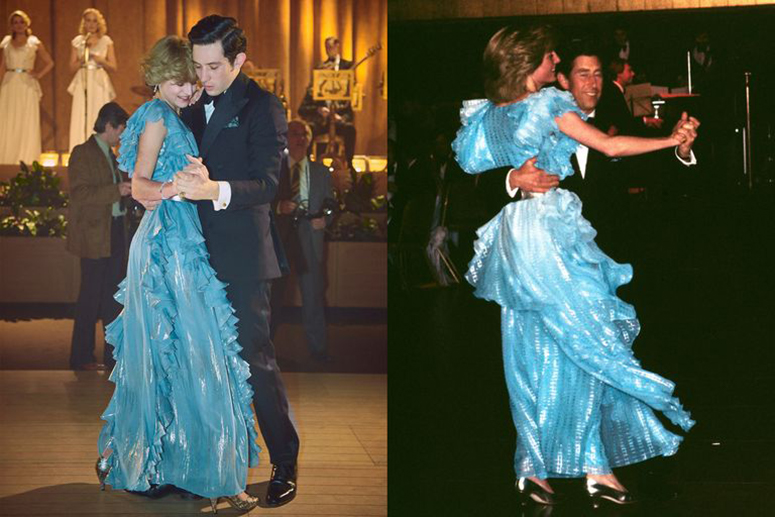
“It’s the Diana people remember, that glamorous sexy, extraordinary girl everyone was drawn to. She puts on this armor, she is going to fight back,” Roberts says.
And fight she does indeed, as she defies Charles’ objections and proceeds with a trip to New York, pursuing her advocacies, which included a visit to AIDS patients, resulting in a public relations triumph that makes her more popular than ever. She basks in this glory at a Manhattan dinner wearing a white gown and bolero based on the design by Victor Edelstein, dazzling the public and the press.
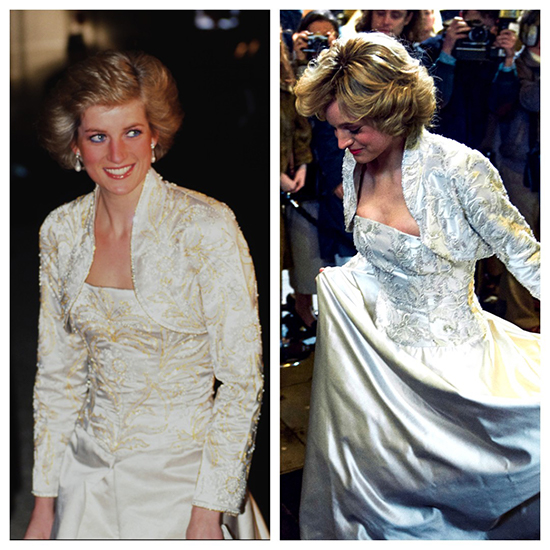
For her final scene of the season, at a Christmas family gathering, she’s in black velvet — showing off powerful shoulders. Inspired by one of Diana’s Catherine Walker gowns, the haltered cut is quite risqué with a color that should only be worn while in mourning, as per royal dress etiquette. So her wearing it for this happy occasion signals her rebellion and impending break from the royals, who have remained unsympathetic to her. Compared to her early girly days at the palace, it says, “I’m all grown up now; I can fight you and I will survive.”
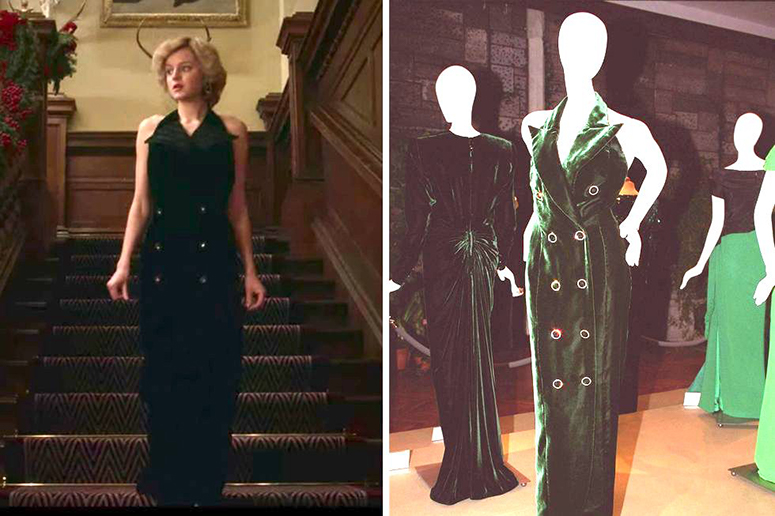
Banner photo: Margaret Thatcher and Gillian Anderson playing her, wearing pussy-bow blouses


